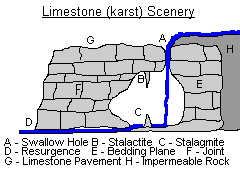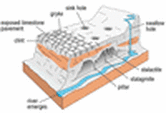With reference to the Irish landscape, examine the processes which have influenced the development of any landform in a karst region. [30m]
SWALLOW HOLE
A swallow hole is a funnel shaped point on the river bed down through which a stream or river flows underground. It is also referred to as a sink hole. Examples of this landform are found in the karst region of the Burren in Co. Clare. One example is found at Poll na gColm.
A karst region is an area of bare limestone rock that is being worn down by chemical weathering.
Distinctive landforms form including the swallow hole.
FORMATION
Swallow holes form on the limestone bedrock of a river. The constant flow of water makes the limestone vulnerable to weathering. This is because Limestone is a permeable rock. This means that water can seep or travel down through it. This is because it has weaknesses that allow water through them.
These include;
Joints – these are vertical cracks in the limestone rock. Water will move down through them.
Bedding Planes – these are horizontal weaknesses that separate one limestone rock layer from another.
It is because of these weaknesses that water can move down from the surface through several underground layers. Limestone is vulnerable to the chemical weathering process of carbonation. This is caused by carbonic acid dissolving the cementing agent (compound agent) of the limestone. This cementing agent is called calcite. The calcite will be dissolved into a solution called calcium bicarbonate. It will be carried away in water. The process of carbonation will be ongoing on the riverbed because of the constant flow of water. Over time, the joints reaching the riverbed will be widened. Below the surface, the bedding planes will also be widened. More and more water will be lost from the surface stream. As more water flows underground, the joints and bedding planes will also be widened by the impact of rover erosion processes such as hydraulic action (the power of the flowing water) and abrasion (the impact of the stream’s load hitting against the sides of the joints and bedding planes).
Eventually the entire flow of water in the stream will disappear down the enlarged joints and bedding planes which have become a swallow hole. The overlying riverbed dries up to form a dry valley. The stream will flow underground and may emerge at a lower level as a spring.
SWALLOW HOLE
A swallow hole is a funnel shaped point on the river bed down through which a stream or river flows underground. It is also referred to as a sink hole. Examples of this landform are found in the karst region of the Burren in Co. Clare. One example is found at Poll na gColm.
A karst region is an area of bare limestone rock that is being worn down by chemical weathering.
Distinctive landforms form including the swallow hole.
FORMATION
Swallow holes form on the limestone bedrock of a river. The constant flow of water makes the limestone vulnerable to weathering. This is because Limestone is a permeable rock. This means that water can seep or travel down through it. This is because it has weaknesses that allow water through them.
These include;
Joints – these are vertical cracks in the limestone rock. Water will move down through them.
Bedding Planes – these are horizontal weaknesses that separate one limestone rock layer from another.
It is because of these weaknesses that water can move down from the surface through several underground layers. Limestone is vulnerable to the chemical weathering process of carbonation. This is caused by carbonic acid dissolving the cementing agent (compound agent) of the limestone. This cementing agent is called calcite. The calcite will be dissolved into a solution called calcium bicarbonate. It will be carried away in water. The process of carbonation will be ongoing on the riverbed because of the constant flow of water. Over time, the joints reaching the riverbed will be widened. Below the surface, the bedding planes will also be widened. More and more water will be lost from the surface stream. As more water flows underground, the joints and bedding planes will also be widened by the impact of rover erosion processes such as hydraulic action (the power of the flowing water) and abrasion (the impact of the stream’s load hitting against the sides of the joints and bedding planes).
Eventually the entire flow of water in the stream will disappear down the enlarged joints and bedding planes which have become a swallow hole. The overlying riverbed dries up to form a dry valley. The stream will flow underground and may emerge at a lower level as a spring.


